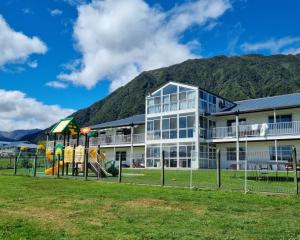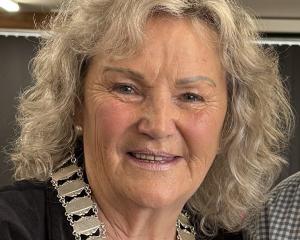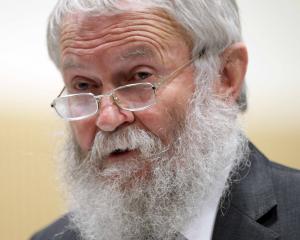It might be going a little far to describe Wayne and Ann Carran as the guardian angels of Milford road users. They would hate that anyway. But after 32 years of protecting tourists and road workers from avalanches, the Te Anau couple are calling it a day with their safety record intact. Mark Price reports.
A D6 bulldozer weighs 16 tonnes.
On September 23, 1983, an avalanche turned one upside down and threw it 40m down the Milford road.
Wayne Carran, the driver, was knocked around but survived.
His supervisor Robert ''Pop'' Andrew (52) was on foot nearby and was killed.
A white cross on a rock marks the place where the accident happened - down the hill from the Milford Sound end of the Homer Tunnel.
The details of what happened are engraved in Mr Carran's memory.
He told the Otago Daily Times last week that as the avalanche struck, smashing the bulldozer's windows, he ducked under the dashboard.
''It was the real deal - a big Milford road avalanche that blasted the bulldozer upside down.''
Mr Carran crawled out of the cab and began digging for Mr Andrew with his hands, then with a small shovel.
But when he found Mr Andrew, he was dead.
Colleagues who could see the bulldozer from the safety of the tunnel entrance assumed both Mr Andrew and Mr Carran had been killed, and left for home, without taking a closer look.
Mr Carran remembers their stunned faces when hours later - after he had climbed out of the debris, found a vehicle and driven himself to Knobbs Flat with frost-bitten hands - he walked in to the Ministry of Works camp there.
That part of the story has not been told publicly before, and Mr Carran resisted the idea it should be raised now.
But, of the lessons he took from the death of Mr Andrew, it is clear the one about taking care of colleagues is primary.
The entire avalanche programme he and wife Ann have devised since taking on the management of the Milford road avalanche programme 32 years ago revolves around the idea that no-one working on the road is put in an unsafe position, or forgotten about.
For instance: At the centre of day-to-day operations is Mrs Carran's Te Anau office.
She is there at 6am to see crews off as they head up the Milford road to clear snow or avalanche debris.
And she is also there at 6pm or whenever the last staff member arrives back from the road.
''We take the approach that it's our work crew and our staff whose safety we are taking care of.
''And if we keep them safe, the by-product will be the road user will be safe.
''And that's always been our approach.''
There are 54 avalanche paths in the 17km avalanche zone. Some paths are 1.6km wide.
When an avalanche drops off the top of a mountain, it can contain more than 200,000 tonnes of ice, snow and granite.
Because the mountains are so steep, much of it does not even touch the sides.
Anyone in its path has about 30 seconds to find cover.
But, in reality, there is no place to hide.
Mr and Mrs Carran accept the same applies to their role.
If something goes wrong, they take the blame.
''You get a lot of stuff thrown at you here,'' Mr Carran said.
''You have to have a good record of managing risk well, rather than saying, `oh f... it, who gives a s... today'.
''As soon as you say that once, you will never get that stigma off the back of your head.''
Over the years, the Carrans have heard their fair share of grumbling about the road being closed.
And that is where another lesson from the death of Mr Andrew comes in.
On the day he died, more than 100 tourists were stranded at Milford Sound by avalanche debris.
Parked by the cross last week, Mr Carran recalled his boss was not comfortable working in the avalanche zone that day, but he felt an obligation to get the tourists out.
Today, there are systems, backed up by technology and science, to take that sort of pressure off individuals.
There are temperature gauges and weighing devices in the snow, weather stations and remotely operated cameras on mountain peaks, and ''95% accurate'' weather forecasts from MetService in Wellington.
''[The programme] could not operate without them,'' Mr Carran said.
''The forecasts when I started here were 20% accurate.
''They were diabolical.''
If analysis of the data comes up with anything other than a low risk of an avalanche then no-one - tourist or worker - can use the road until the risk is reduced.
Usually, that involves a helicopter dropping bags of explosives to trigger avalanches.
''I never get sick of beating them at their own game and knocking them down,'' Mr Carran said.
''There's a huge sense of satisfaction being able to drag them off.''
The great plumes of snow ''free plunging'' to the road on the valley floor look deceptively light and fluffy as they fall, Mr Carran says.
But there is a photo of a big yellow road sign with its black lettering stripped off, not by snow or rock but by the wind ahead of an avalanche.
This winter has been a busy one, reminiscent of the 1990s, Mr Carran said, when ''we were just surrounded by avalanches, week after week''.
''Just staying alive was an achievement.''
But oddly, it is not the stress of dealing with Milford's natural forces the couple finds most exhausting.
It is dealing with the administration.
Mrs Carran said she decided she had finally reached the end of the road during a meeting in February with roading managers.
She found herself explaining and justifying operational practices she had explained and justified many times before.
''I sat down one time too many trying to educate a group of people about the avalanche programme and the safety issues with the road and ... it's time for somebody else to do this.
''I'm tired and I'm cynical and it's time to move on.''
Mr Carran said it would be nice for them to ''get our lives back''.
''Our whole lives have been on hold. You can't do this job half-arsed.''
He talks of ''fighting to defend'' the programme from budget cuts.
''We could have rolled over but we haven't come this far to be stepping back.''
Much of Mr Carran's satisfaction comes from having built from scratch a safety system that works, and it is now acknowledged by avalanche experts in places such as Alaska and Switzerland.
At one time, those working on the programme were regarded as ''just a bunch of contractors'', Mr Carran said.
Now, ''the Kiwis from the Milford road'' get top billing at international avalanche conferences.
Mr Carran acknowledged the teamwork involved and, in particular, the technical inventiveness of Stewart Hall, of Dunedin, who had worked on the programme for more than 30 years.
He recalled with some pride an Alaskan at a recent avalanche conference in the United States declaring: ''You boys have got it nailed.''












